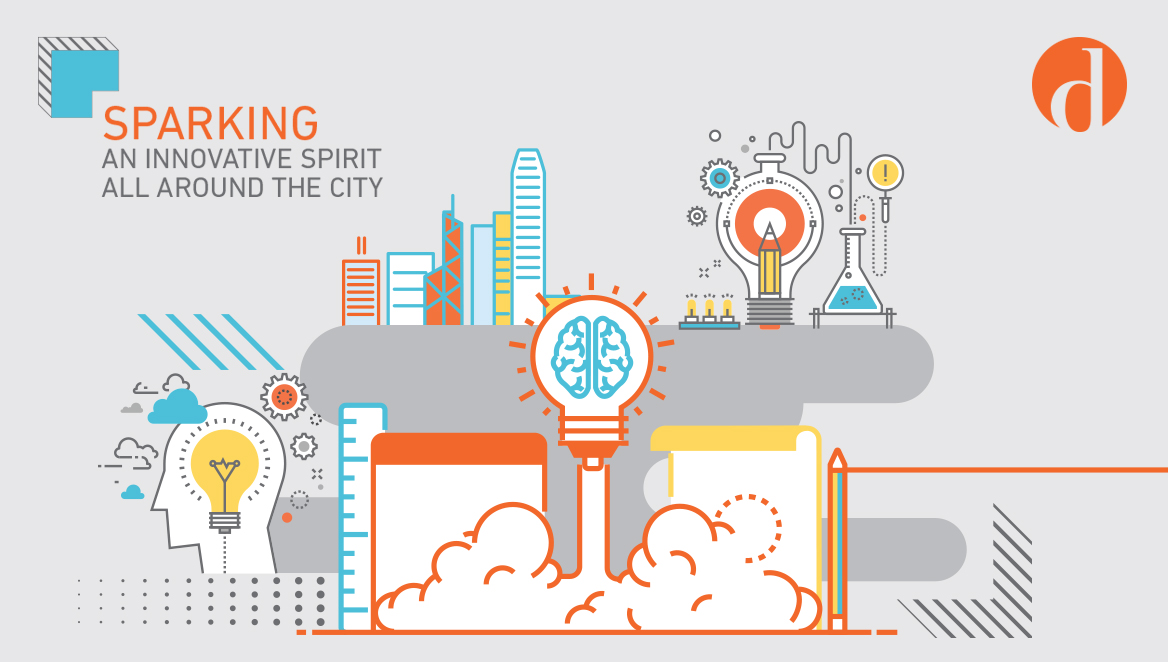DMatters August 2018 Issue

Sparking the Innovative Spirit of Cities
Many major cities around the globe share a common vision of developing their creative industry, investing more money than ever on cultural infrastructure. Hong Kong is also introducing some new cultural venues lately that are boosting the city’s convivial vibe, like the new Tai Kwun - the revitalised former Central Police Station and Victoria Prison. But the real value of creativity is not only confined to the arts and cultural sector. With proper mediation, the creative energy of design talents can be channelled to kindle the innovative spirit of our city. Such power can radiate out to all sectors and cast new light on social problems, transforming the urban environment and even how the public sector works. Apart from building the hardware, we need to create a conducive environment for the creative ecology to thrive. In our Knowledge of Design Week (KODW) this year, government officials, cultural leaders and innovators shared their trailblazing experience in carving out a niche in society for and with the creative.
Philippe Kern, CEO and Founder of KEA European Affairs, illustrated why Europe is proactively investing in the creative sector despite economic pressure. Many European countries believe that creativity can catalyse innovations and offer a disruptive way to address lingering social issues such as the recent migration crisis. The UNESCO Creative Cities Network now boasts a whopping 180 cities from 72 countries, testifying the cities’ espousal of creativity and design.
Shifting the lens to Asia, we find Thailand’s rapidly developing economies underpinned by an expanding creative economy which accounted for 13.2% of its GDP in 2014 and employed more than 860,000 professionals in 2016. The Thailand Creative & Design Center (TCDC) is a major advocate behind such development. Deputy Managing Director Kittiratana Pitipanich considers themselves a change agent and an interface between the creative sector and all other industries. Focusing on establishing the Charoenkrung Creative District these few years, they turned a historical post office in the area into their office as well as a creative hub for the local community. Such effort won them the DFA Design for Asia Award in 2017. They prototyped new ideas together with the creative community. Among them, a new bus stop signage system created by a local design studio was instantly adopted by the authorities to replace the current confusing bus route maps. Kittiratana sees the power of prototyping “in convincing the government to believe in the possibilities and getting them out of the routine.”
Ada Wong, Convenor of Make a Difference (MaD) based in Hong Kong, sees the importance of empowering young people and channelling their creativity into making positive social changes. In their latest project the Social Lab, they have partnered with government departments to re-design public facilities, such as libraries, parks and streets. Putting together teams of young designers, architects, marketers and other professionals, they reimagined these amenities and created innovative prototypes through design thinking and ethnography. In their Tin Shui Collaborative project, the MaD team and young artists invited stall owners in an open market in Tin Shui Wai to create their own shop signs. This amiable act empowered the stall owners and reduced the hostility among them. Ada believes that “when we think about creative cities and creative vibes, we should not only focus on the economic side but also their social impact.”
Newly appointed as the Artistic Director for Performing Arts at the West Kowloon Cultural District Authority (WKCDA), Alison Friedman is bringing to Hong Kong her 15 years’ experience working with the cultural sector in China. WKCDA has been clear that building up a city’s creative ecology requires far more than the physical infrastructure. They are driven by a long-term vision to support the growth of local artists. For example, they are investing in the next generation of Cantonese opera artists and lifting them to the national level years before the upcoming opening of the performance venues. The Freespace Fest outdoor music and multi-arts festival has provided a breeding ground for artistic and cultural experimentation. Alison believes that “government support, corporate sponsorship and individual philanthropy” should all work together “in the service of artists and performing arts groups like an ecosystem.”
By bridging the creative cluster with the public sector, we can transform public services and our urban environment in surprising ways. Creativity offers value far beyond the scope of arts and culture. It is conducive to innovation and economic growth. It is what the future of cities is hinged on.
In this issue of DMatters, we are taking a look back at Fashion Movement, an in-situ creative performance during this year’s KODW which blended fashion, music and choreography together. Then we are joining the participants of the 11th 7+1 Entrepreneurship for Design & Creative Business Certificate Programme to hear what they have learnt. Wrapping up is a sneak peek at Business of Design Week 2018, a highly anticipated event on design, innovation and brands of the year.
Further Readings:
TCDC’s Co-creating Charoenkrung Project
http://www.tcdc.or.th/calendar/activities/24007/?lang=en#Co-Create-Charoenkrung-Project
MaD’s Healthy Street Lab:
http://www.mad.asia/programmes/mad-social-lab/224
WKCDA’s Freespace Happening:
https://www.westkowloon.hk/en/freespacehappening
More about Knowledge of Design Week (KODW) 2018 “Design for Liveability”
www.kodw.org
Click here to read the full issue of DMatters August 2018.